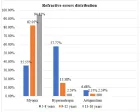Abstract
Research Article
Enamel demineralization with resin modified gic and conventional composite resin - a comparative in vivo study
Gautam G*, Shashikala Kumari V, Garima Garg and Vikram Shetty
Published: 31 July, 2017 | Volume 2 - Issue 3 | Pages: 069-079
Background & Objectives: Fluoride releasing bonding agents can help the orthodontist to minimize enamel demineralization independent of patient cooperation. This in vivo study was conducted to evaluate the efficacy of resin modified glass ionomer cement (RMGIC) on reducing enamel demineralization around orthodontic brackets and confirm the superior caries-preventive effect of RMGIC by assessing the mutans streptococci (S. mutans) in plaque samples in vitro.
Methods: 60 subjects (aged 14-20 years) scheduled to have premolar extractions as part of the orthodontic treatment plan were selected and randomly divided into 2 groups of 30 each (group 1: the brackets were bonded on the teeth using light cure composite resin and group 2: the brackets were bonded using RMGIC). Plaque scores (modification of plaque index by Silness and Loe) were recorded and plaque samples were collected before bonding, one week and one month after bonding. S.mutans colonies were recorded from the plaque samples inoculated on MSB agar plates, incubated under 95% N2 and 5% CO2 for 48 hours at 370C in a CO2 jar. After 1 month, the right maxillary and mandibular first premolars were debonded, extracted and depth of enamel demineralization area was estimated using polarized light microscope.
Results: After statistical analysis, a significantly higher mean depth of demineralized lesions was noticed in group 1 as compared to group 2. A significant difference between occlusal and gingival depth was seen only in group 2, thus illustrating a wedge effect. In group 1, a statistically significant increase in the mean colony forming units (CFU) of S.mutans has been noticed at different time intervals whereas in group2, a significant increase was observed only at 1month. Unlike at 1 month, a statistically significant difference in mean CFU between group 1 and group 2 has been observed at 1 week (P<0.05).
Conclusions: Enamel lesions adjacent to the bracket base on teeth bonded with the RMGIC were smaller than those on teeth bonded with a composite resin. The high “burst effect” of fluoride release for the first few days of RMGIC after bonding is confirmed by statistically significant reduction in CFU counts of S. mutans in plaque.
Read Full Article HTML DOI: 10.29328/journal.johcs.1001014 Cite this Article Read Full Article PDF
Keywords:
RMGIC; White spot lesion; Enamel demineralization; Mutans streptococci
References
- O'Reilly MM, Featherstone JDB. Demineralization and remineralization around orthodontic appliances: an in vivo study.Am J Orthod Dentofacial Orthop. 1987; 92: 33-40. Ref.: https://goo.gl/bicr2b
- Sundararaj D, Venkatachalapathy S, Tandon A, Pereira A. Critical evaluation of incidence and prevalence of white spot lesions during fixed orthodontic appliance treatment: A meta-analysis. J Int Soc Prev Community Dent. 2015; 5: 433-439. Ref.: https://goo.gl/XZa6rN
- Tantbirojn D, Douglas WH, Versluis A. Inhibitive effect of a resin-modified glass ionomer cement on remote enamel artificial caries. Caries Res. 1997; 31: 275-280. Ref.: https://goo.gl/bDFZRS
- Pascotto RC, Navarro MF, Capelozza Filho L, Cury JA. In vivo effect of a resin-modified glass ionomer cement on enamel demineralization around orthodontic brackets. Am J Orthod Dentofacial Orthop. 2004; 125: 36-41. Ref.: https://goo.gl/ZRkcsf
- Lundström F, Krasse B. Streptococcus mutans and lactobacilli frequency in orthodontic patients; the effect of chlorhexidine treatments. Eur J Orthod. 1987; 9: 109-116. Ref.: https://goo.gl/EyKNCa
- Marsh PD. Dental plaque as a biofilm: the significance of pH in health and caries. Compend Contin Educ Dent. 2009; 30: 76-78. Ref.: https://goo.gl/QH38Wf
- Wright AB, Lee RT, Lynch E, Young KA. Clinical and microbiologic evaluation of a resin modified glass ionomer cement for orthodontic bonding. Am J Orthod Dentofacial Orthop. 1996; 110: 469-475. Ref.: https://goo.gl/ayjyN7
- Wheeler AW, Foley TF, Mamandras A. Comparison of fluoride release protocols for in-vitro testing of 3 orthodontic adhesives. Am J Orthod Dentofacial Orthop. 2002; 121: 301-309. Ref.: https://goo.gl/ff35KV
- Hammersfahr P. Developments in resionomer systems in glass-ionomers. In: Hunt PR, editor. Glass ionomers: the next generation. Proceedings of the 2nd International Symposium on Glass-Ionomers. Philadelphia, PA: International Symposia in Dentistry. 1994; 47-55.
- Tarn LE, Chan GP, Yim D. In vitro caries inhibition effects by conventional and resinmodified glass-ionomer restorations. Oper Dent. 1997; 22: 4-14. Ref.: https://goo.gl/iy1SMb
- Vorhies BA, Donly KJ, Staley RN, Wefel JS. Enamel demineralization adjacent to orthodontic brackets bonded with hybrid glass ionomer cements: An in vitro study. Am J Orthod Dentofacial Orthop. 1998; 114: 668-674. Ref.: https://goo.gl/TzqnVz
- Matalon S, Slutzky H, Weiss EI. Antibacterial properties of 4 orthodontic cements. Am J Orthod Dentofacial Orthop. 2005; 127: 56-63. Ref.: https://goo.gl/87eb84
- Schmit JL, Staley RN, Wefel JS, Kanellis M, Jakobsen JR, et al. Effect of fluoride varnish on demineralization adjacent to brackets bonded with RMGI cement. Am J Orthod Dentofacial Orthop. 2002; 122: 125-134. Ref.: https://goo.gl/QGSsqr
- Gorton J, Featherstone JD. In vivo inhibition of demineralization around orthodontic brackets. Am J Orthod Dentofacial Orthop. 2003; 123: 10-14. Ref.: https://goo.gl/tq4nDo
- Rosenbloom RG, Tinanoff N. Salivary Streptococcus mutans levels in patients before, during, and after orthodontic treatment. Am J Orthod Dentofacial Orthop. 1991; 100: 35-37. Ref.: https://goo.gl/Mzm1pU
- Amezquita AN, Lucia MT, Jaramillo A, Betancourth M, Enrique JB. Changes in the subgingival microbiota and periodontal parameters before and 3 months after bracket placement. Am J Orthod Dentofacial Orthop. 2006; 130: 275. Ref.: https://goo.gl/EKAETb
- Newbrun E. Cariology 3rd ed. Quintessence Publishing Co. Inc, Chicago, Illinois. 1989; 13-61.
- Silverman E, Cohen M, Demke RS, Silverman M. A new light-cured glass ionomer cement that bonds brackets to teeth without etching in the presence of saliva. Am J Orthod Dentofacial Orthop. 1995; 108: 231-236. Ref.: https://goo.gl/8MrU4W
- Gutiérrez de Annan S, de Valladares RER, de Cardenas ILB. Mitis salivarius-bacitracin 10% sacarose agar for oral streptococci and Streptococcus mutans counts. Acta Odontol Latinoam. 1997; 10: 47-53. Ref.: https://goo.gl/smygjr
- Mattingly JA, Sauer GJ, Yancey JM, Arnold RR. Enhancement of Streptococcus mutans Colonization by Direct Bonded Orthodontic Appliances. J Dent Res. 1983; 62: 1209-1211. Ref.: https://goo.gl/bjgxLk
- Yengopal V, Mickenautsch S. Caries-preventive effect of resin-modified glass-ionomer cement (RM-GIC) versus composite resin: a quantitative systematic review. Eur Arch Paediatr Dent. 2011; 12: 5-14. Ref.: https://goo.gl/93rPqg
- Brantley AW, Eliades T. editors: Orthodontic materials- scientific and clinical aspects, Stuttgart, Germany. 2001.
- Friedl KH, Schmalz G, Hiller KA, Shams M. Resin-modified glass ionomer cements: fluoride release and influence on Streptococcus mutans growth. Eur J Oral Sci. 1997; 105: 81-85. Ref.: https://goo.gl/iaE1BJ
- Fishman SA, Tinanoff N. The effect of acid and fluoride release on the antimicrobial properties of four glass ionomer cements. Pediatr Dent. 1994; 16: 368-370. Ref.: https://goo.gl/C3CmCZ
- Ahn SJ, Lim BS, Lee YK, Nahm DS. Quantitative Determination of Adhesion Patterns of Cariogenic Streptococci to Various Orthodontic Adhesives. Angle Orthod. 2006; 76: 869-875. Ref.: https://goo.gl/HBQo3s
- McGhee JR, Michalek SM. Immunobiology of dental caries: microbial aspects and local immunity. Annu Rev MicrobioI. 1981; 35: 595-638 Ref.: https://goo.gl/o3wDXc
Figures:

Figure 1

Figure 2

Figure 3

Figure 4

Figure 5
Similar Articles
-
Enamel demineralization with resin modified gic and conventional composite resin - a comparative in vivo studyGautam G*,Shashikala Kumari V,Garima Garg,Vikram Shetty. Enamel demineralization with resin modified gic and conventional composite resin - a comparative in vivo study . . 2017 doi: 10.29328/journal.johcs.1001014; 2: 069-079
Recently Viewed
-
Host biomarkers for early diagnosis of infectious diseases: A comprehensive reviewArindam Chakraborty*,Singh Monica. Host biomarkers for early diagnosis of infectious diseases: A comprehensive review. Int J Clin Microbiol Biochem Technol. 2019: doi: 10.29328/journal.ijcmbt.1001005; 2: 001-007
-
Diabetes and red blood cell parametersMd. Sadikuj Jaman*,Md. Sohanur Rahman,Rubaiya Rafique Swarna,Joyanto Mahato,Md. Milon Miah,Mosa. Ayshasiddeka. Diabetes and red blood cell parameters. Ann Clin Endocrinol Metabol. 2018: doi: 10.29328/journal.acem.1001004; 2: 001-009
-
Indian spices and Caffeine treatment for Obesity and Cardiovascular diseaseIan James Martins*. Indian spices and Caffeine treatment for Obesity and Cardiovascular disease. Ann Clin Endocrinol Metabol. 2018: doi: 10.29328/journal.acem.1001005; 2: 010-014
-
New pharmacological strategies in some metabolic endocrine disorder under a toxicological approachLuisetto M*,Ghulam Rasool Mashori,Cabianca luca. New pharmacological strategies in some metabolic endocrine disorder under a toxicological approach. Ann Clin Endocrinol Metabol. 2018: doi: 10.29328/journal.acem.1001006; 2: 015-021
-
Exercise preserves pancreatic β-cell mass and function in obese OLETF ratsJiawei Zhao,Zhihong Yang,Min He,Qinghua Wang,Renming Hu*. Exercise preserves pancreatic β-cell mass and function in obese OLETF rats. Ann Clin Endocrinol Metabol. 2018: doi: 10.29328/journal.acem.1001007; 2: 022-029
Most Viewed
-
Impact of Latex Sensitization on Asthma and Rhinitis Progression: A Study at Abidjan-Cocody University Hospital - Côte d’Ivoire (Progression of Asthma and Rhinitis related to Latex Sensitization)Dasse Sery Romuald*, KL Siransy, N Koffi, RO Yeboah, EK Nguessan, HA Adou, VP Goran-Kouacou, AU Assi, JY Seri, S Moussa, D Oura, CL Memel, H Koya, E Atoukoula. Impact of Latex Sensitization on Asthma and Rhinitis Progression: A Study at Abidjan-Cocody University Hospital - Côte d’Ivoire (Progression of Asthma and Rhinitis related to Latex Sensitization). Arch Asthma Allergy Immunol. 2024 doi: 10.29328/journal.aaai.1001035; 8: 007-012
-
Causal Link between Human Blood Metabolites and Asthma: An Investigation Using Mendelian RandomizationYong-Qing Zhu, Xiao-Yan Meng, Jing-Hua Yang*. Causal Link between Human Blood Metabolites and Asthma: An Investigation Using Mendelian Randomization. Arch Asthma Allergy Immunol. 2023 doi: 10.29328/journal.aaai.1001032; 7: 012-022
-
An algorithm to safely manage oral food challenge in an office-based setting for children with multiple food allergiesNathalie Cottel,Aïcha Dieme,Véronique Orcel,Yannick Chantran,Mélisande Bourgoin-Heck,Jocelyne Just. An algorithm to safely manage oral food challenge in an office-based setting for children with multiple food allergies. Arch Asthma Allergy Immunol. 2021 doi: 10.29328/journal.aaai.1001027; 5: 030-037
-
Snow white: an allergic girl?Oreste Vittore Brenna*. Snow white: an allergic girl?. Arch Asthma Allergy Immunol. 2022 doi: 10.29328/journal.aaai.1001029; 6: 001-002
-
Cytokine intoxication as a model of cell apoptosis and predict of schizophrenia - like affective disordersElena Viktorovna Drozdova*. Cytokine intoxication as a model of cell apoptosis and predict of schizophrenia - like affective disorders. Arch Asthma Allergy Immunol. 2021 doi: 10.29328/journal.aaai.1001028; 5: 038-040

If you are already a member of our network and need to keep track of any developments regarding a question you have already submitted, click "take me to my Query."















































































































































